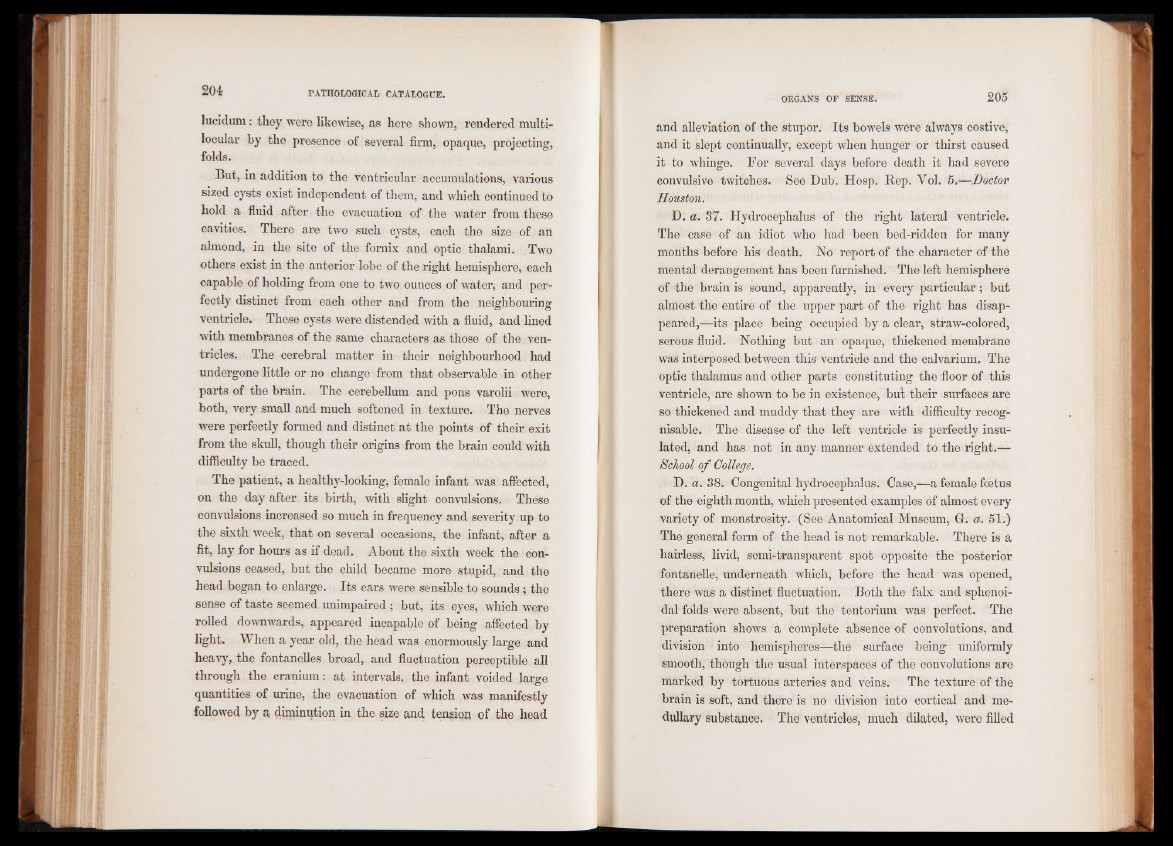
lucidum: they were likewise, as here shown, rendered multi-
locular by the presence of several firm, opaque, projecting,
folds.
But, in addition to the ventricular accumulations, various
sized cysts exist independent of them, and which continued to
hold a fluid after the evacuation of the water from these
cavities. There are two such cysts, each the size of an
almond, in the site of the fornix and optic thalami. Two
others exist in the anterior lobe of the right hemisphere, each
capable of holding from one to two ounces of water, and perfectly
distinct from each other and from the neighbouring
ventricle. These cysts were distended with a fluid, and fined
with membranes of the same characters as those of the ventricles.
The cerebral matter in their neighbourhood had
undergone little or no change from that observable in other
parts of the brain. The cerebellum and pons varolii were,
both, very small and much softened in texture. The nerves
were perfectly formed and distinct at the points of their exit
from the skull, though their origins from the brain could with
difficulty be traced.
The patient, a healthy-looking, female infant was affected,
on the day after its birth, with slight convulsions. These
convulsions increased so much in frequency and severity up to
the sixth week, that on several occasions, the infant, after a
fit, lay for hours as if dead. About the sixth week the convulsions
ceased, but the child became more stupid, and the
head began to enlarge. Its ears were sensible to sounds; the
sense of taste seemed unimpaired ; but, its eyes, which were
rolled downwards, appeared incapable of being affected by
light. When a year old, the head was enormously large and
heavy, the fontanelles broad, and fluctuation perceptible all
through the cranium: at intervals, the infant voided large
quantities of urine, the evacuation of which was manifestly
followed by a diminution in the size and tension of the head
and alleviation of the stupor. Its bowels were always costive,
and it slept continually, except when hunger or thirst caused
it to whinge. For several days before death it had severe
convulsive twitches. See Dub. Hosp. Rep. Vol. 5.—Doctor
Houston.
D. a. 37. Hydrocephalus of the right lateral ventricle.
The case of an idiot who had been bed-ridden for many
months before his death. No report of the character of the
mental derangement has been furnished. The left hemisphere
of the brain is sound, apparently, in every particular; but
almost the entire of the upper part of the right has disappeared,—
its place being occupied by a clear, straw-colored,
serous fluid. Nothing but an opaque, thickened membrane
was interposed between this ventricle and the calvarium. The
optic thalamus and other parts constituting the floor of this
ventricle, are shown to be in existence, but their surfaces are
so thickened and muddy that they are with difficulty recognisable.
The disease of the left ventricle is perfectly insulated,
and has not in any manner extended to the right.—
School of College.
D. a. 38. Congenital hydrocephalus. Case,—a female foetus
of the eighth month, which presented examples of almost every
variety of monstrosity. (See Anatomical Museum, G-. a. 51.)
The general form of the head is not remarkable. There is a
hairless, livid, semi-transparent spot opposite the posterior
fontanelle, underneath which, before the head was opened,
there was a distinct fluctuation. Both the falx and sphenoidal
folds were absent, but the tentorium was perfect. The
preparation shows a complete absence of convolutions, and
division into hemispheres—the surface being uniformly
smooth, though the usual interspaces of the convolutions are
marked by tortuous arteries and veins. The texture of the
brain is soft, and there is no division into cortical and medullary
substance. The ventricles, much dilated, were filled